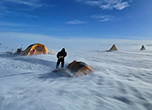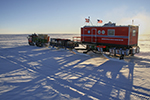|
Science - Ice and Snow Most Recent
Quick Find
More ResultsAug
09
2021
Warm Ocean Water is Eroding Thwaites Ice Shelf From BelowScientists got their first glimpse at the ocean conditions surrounding the Thwaites Ice Shelf in 2019, and recently published results are worrisome for the rapidly melting ice shelf and the glacier behind it. Jul
12
2021
Radar Satellites Spot Dangerous Crevasses Humans Can't SeeAntarctic researchers and support staff can now more easily find and avoid dangerous crevasses on long traverses carrying supplies to remote camps and stations, thanks to the help of a German radar satellite. Jun
30
2021
Ice core tells 11,000-year history of explosive volcanic eruptionsAn ice core from West Antarctica is giving scientists insight into some intriguing climate anomalies of ages past and deepening the mystery of a volcanic eruption that destroyed a Greek island some 3,600 years ago. May
17
2021
Thwaites Glacier - FutureThe massive Thwaites Glacier on the coast of West Antarctica is falling to pieces because of climate change. Shifting ocean currents are bringing warm sea water up under its vulnerable underside, melting out the ice at its base and accelerating its movement into the ocean. May
03
2021
Thwaites Glacier - PresentThwaites Glacier is melting fast because of climate change, causing sea levels to rise the world over. Of all the world's glaciers, it's the one that scientists are most worried that a catastrophic collapse could happen quickly and affect coastal regions everywhere. Apr
21
2021
Thwaites Glacier - PastAntarctica's massive Thwaites Glacier is melting because of climate change, and if it collapses completely, could add about two feet to global sea level. Glaciologists are tracking it with alarm, as Thwaites has lost a tremendous amount of mass over recent decades, but its remote location in West Antarctica makes getting an up-close look at it extremely difficult. Jul
13
2020
Where the Ice Layers GrowHunting for the perfect patch of ice can be a herculean task. Knut Christianson, of the University of Washington, spent three weeks with his research team in a barren and remote part of Antarctica, scouring the landscape for the perfect spot. Jan
26
2020
Hunting For the Oldest IceFor scientists, ice cores are an indispensable window into the past. A research team using ancient ice recovered from Antarctica, announced recently that they'd identified some of the oldest air samples ever discovered, as far back as 2 million years ago, and that they're going back for more. Nov
05
2019
SALSA Part I: Scratching the SurfaceA team of researchers and drilling engineers recently spent six weeks in West Antarctica carefully drilling through nearly a mile of ice to study Mercer Subglacial Lake. This body of water is buried under an ice stream, and likely hasn't seen the light of day for at least thousands and possibly hundreds of thousands, of years. Mar
18
2019
The First Wave of the "Thwaites Invasion"The U.S. and U.K.-funded International Thwaites Glacier Collaboration (ITGC) officially kicked off its science field research in January, when four researchers and their support teams set foot on a remote, fast-melting glacier in West Antarctica, establishing a beachhead for an unprecedented international project to determine the glacier's fate. Jul
26
2018
Buried TreasureA team of researchers has brought home samples of some of the oldest ice ever discovered, more than twice as old as most previous samples. In the remote Ong Valley, the team drilled into a bed of ice - that first fell as snow two million years ago, or more. Jun
27
2018
IceBridge Flies HighIn late 2017, a specially modified airplane contracted by NASA crisscrossed Antarctica, mapping the ice below and filling in a data gap left by a now-defunct NASA satellite called ICESat, which measured the elevation of the ice surface using a laser. Operation IceBridge flights are bridging the gap between ICESat and its successor, ICESat-2. Feb
14
2018
Circumnavigating the Pole HoleIn January, researchers went for a more than 750-kilometer drive around the South Pole. The team followed the arc of the 88th parallel for a quarter of its distance ringing the South Pole. Their cargo was a sensitive GPS unit to record the exact elevation of the ice sheet they drove over. The effort is in support of NASA's ICESat-2 satellite, a mission devoted to measuring ice levels around the world, particularly in the polar regions.
|
||||||||||||||||||||||||||||||



For USAP Participants |
For The Public |
For Researchers and EducatorsContact UsNational Science FoundationOffice of Polar Programs Geosciences Directorate 2415 Eisenhower Avenue, Suite W7100 Alexandria, VA 22314 Sign up for the NSF Office of Polar Programs newsletter and events. Feedback Form |



